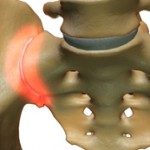Sacroiliitis – A Painful and Sometimes Misdiagnosed Spinal Condition
Sacroiliitis is a condition in which the sacroiliac joint – the large joint located between the sacrum (the tailbone) and the ilium (the pelvis) becomes inflamed or disrupted, and causes pain. There are two sacroiliac joints, one on the right side and one on the left, and they are responsible for transferring weight and forces between your upper body and legs. Sacroiliitis can be seen after trauma to the pelvis, in individuals with inflammatory disorders such as ankylosing spondylitis, and in patients with a history of previous lumbar surgery.
An arthritic sacroiliac joint that is undergoing degeneration is also among the causes of sacroiliitis. In women, postpartum sacroiliac pain after vaginal delivery is not uncommon and often resolves spontaneously. However chronic postpartum sacroiliitis may persist and can be quite disabling. Symptoms of sacroiliitis include pelvis/buttock pain, low back pain, hip/groin pain, lower extremity pain, numbness, tingling, and/or weakness, unilateral leg instability (that is, affecting only one side), discomfort when sitting, and trouble sleeping.
The sacroiliitis diagnosis can be difficult to make, and patients have often undergone workup and treatment for lumbar spine and/or hip disorders including surgery, possibly on the lumbar spine or hips, before the correct diagnosis is made. Patients who have not experienced symptomatic relief from lumbar spine or hip surgery could be suffering from inflamed sacroiliac joint dysfunction and sacroiliitis.
Treatment Options for Sacroiliitis
Treatment for sacroiliitis may include physical therapy and exercises for sacroiliitis, chiropractic manipulations, use of oral medications, and injection therapy. Intermittent use of a pelvic belt may provide symptomatic relief from sacroiliitis pain as well. For those patients who fail to respond to these sacroiliitis treatment measures, surgical intervention to stabilize and fuse the sacroiliac could be considered.
Until recently, this procedure was very complex and was performed through large incisions, but the procedure can now be performed using minimally invasive surgery techniques through a small incision (approximately 2-3cm long), along the side of the patient’s buttock. During the procedure, live real-time x-ray imaging (fluoroscopy) facilitates proper placement of titanium metallic implants across the sacroiliac joint. Normally, three implants will be used, depending on the patient’s size. The procedure takes approximately one hour, and patients are often discharged the same day.
At New Jersey Spine Specialists, our board certified orthopedic surgeons have extensive experience providing this sacroiliitis treatment for patients throughout New Jersey including towns like Madison, Morristown, Bernardsville, and Basking Ridge in Morris, Essex, and Union Counties and beyond. We are committed to finding the best solution for each patient, and we welcome the opportunity to have a spine surgeon from one of our offices in NJ meet with you to discuss the complete range of treatment options available.


 At New Jersey Spine Specialists, we provide a variety of treatments for spine conditions. Our doctors are specially trained in treating all spine conditions with care and precision.
At New Jersey Spine Specialists, we provide a variety of treatments for spine conditions. Our doctors are specially trained in treating all spine conditions with care and precision.





